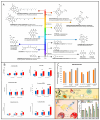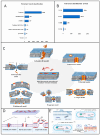Research on Food Preservation Based on Antibacterial Technology: Progress and Future Prospects
- PMID: 39064897
- PMCID: PMC11279653
- DOI: 10.3390/molecules29143318
Research on Food Preservation Based on Antibacterial Technology: Progress and Future Prospects
Abstract
The nutrients present in food are not only prone to a series of physicochemical reactions but also provide conditions for the growth and reproduction of foodborne microorganisms. In recent years, many innovative methods from different fields have been introduced into food preservation, which extends the shelf life while maximizing the preservation of the original ingredients and properties of food. In this field, there is a lack of a systematic summary of new technologies emerging. In view of this, we overview the innovative methods applied to the field of food preservation in recent 3 years, focusing on a variety of technological approaches such as antimicrobial photodynamic therapy based on nanotechnology, electromagnetic radiation sterilization based on radiation technology, and antimicrobial peptides based on biomolecules. We also discuss the preservation mechanism and the application of the different methods to specific categories of products. We evaluated their advantages and limitations in the food industry, describing their development prospects. In addition, as microorganisms are the main causes of food spoilage, our review also has reference significance for clinical antibacterial treatment.
Keywords: antimicrobial peptides; food preservation; ionizing radiation; photodynamics.
Conflict of interest statement
The authors declare no conflicts of interest.
Figures






Similar articles
-
Nanomaterials with Enzyme-like Properties for Combatting Foodborne Pathogen Infections: Classifications, Mechanisms, and Applications in Food Preservation.J Agric Food Chem. 2024 May 8;72(18):10179-10194. doi: 10.1021/acs.jafc.4c00872. Epub 2024 Apr 29. J Agric Food Chem. 2024. PMID: 38685503 Review.
-
Lactoferricin, an antimicrobial motif derived from lactoferrin with food preservation potential.Crit Rev Food Sci Nutr. 2024;64(25):9032-9044. doi: 10.1080/10408398.2023.2207650. Epub 2023 May 9. Crit Rev Food Sci Nutr. 2024. PMID: 37158176 Review.
-
A review of curcumin-mediated photodynamic bactericidal technology for food preservation: Limitations and improvement strategies.Food Microbiol. 2025 Oct;131:104802. doi: 10.1016/j.fm.2025.104802. Epub 2025 Apr 21. Food Microbiol. 2025. PMID: 40484523 Review.
-
Recent approaches in the application of antimicrobial peptides in food preservation.World J Microbiol Biotechnol. 2024 Sep 9;40(10):315. doi: 10.1007/s11274-024-04126-4. World J Microbiol Biotechnol. 2024. PMID: 39249587 Review.
-
Nanotechnological interventions in bacteriocin formulations - advances, and scope for challenging food spoilage bacteria and drug-resistant foodborne pathogens.Crit Rev Food Sci Nutr. 2025;65(6):1126-1143. doi: 10.1080/10408398.2023.2289184. Epub 2023 Dec 9. Crit Rev Food Sci Nutr. 2025. PMID: 38069682 Review.
Cited by
-
The effect of Chinese herbal medicines on the storage quality of sweet potato.Front Plant Sci. 2025 Jul 28;16:1623582. doi: 10.3389/fpls.2025.1623582. eCollection 2025. Front Plant Sci. 2025. PMID: 40791785 Free PMC article.
References
-
- Fuenmayor C.A., Licciardello F. The challenges of food preservation materials and technologies for a more sustainable world. Food Packag. Shelf Life. 2024;43:101273. doi: 10.1016/j.fpsl.2024.101273. - DOI
-
- Muthuvelu K.S., Ethiraj B., Pramnik S., Raj N.K., Venkataraman S., Rajendran D.S., Bharathi P., Palanisamy E., Narayanan A.S., Vaidyanathan V.K., et al. Biopreservative technologies of food: An alternative to chemical preservation and recent developments. Food Sci. Biotechnol. 2023;32:1337–1350. doi: 10.1007/s10068-023-01336-8. - DOI - PMC - PubMed
-
- Khezerlou A., Zolfaghari H., Forghani S., Abedi-Firoozjah R., Sani M.A., Negahdari B., Jalalvand M., Ehsani A., McClements D.J. Combining Non-Thermal Processing Techniques with Edible Coating Materials: An Innovative Approach to Food Preservation. Coatings. 2023;13:830. doi: 10.3390/coatings13050830. - DOI
Publication types
MeSH terms
Substances
LinkOut - more resources
Full Text Sources
Medical

